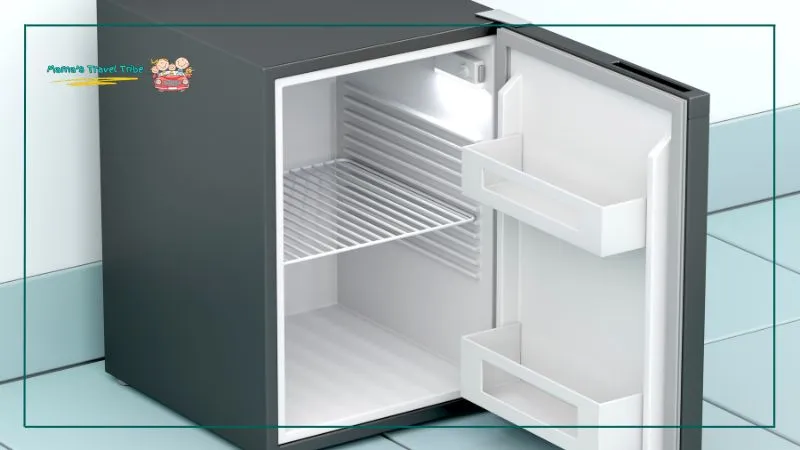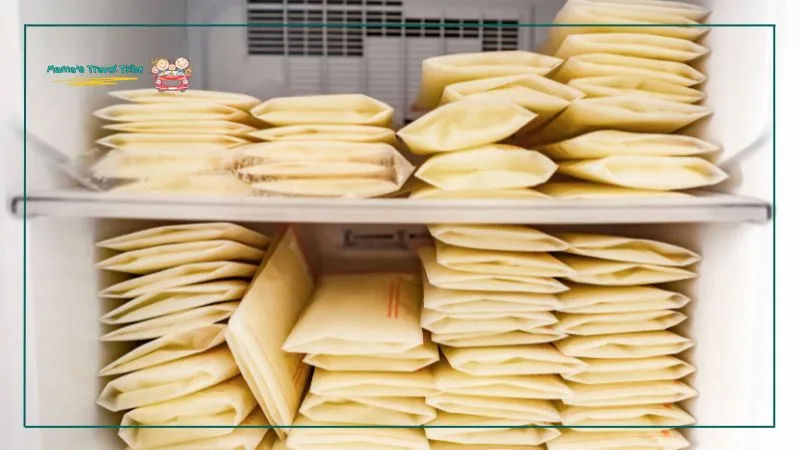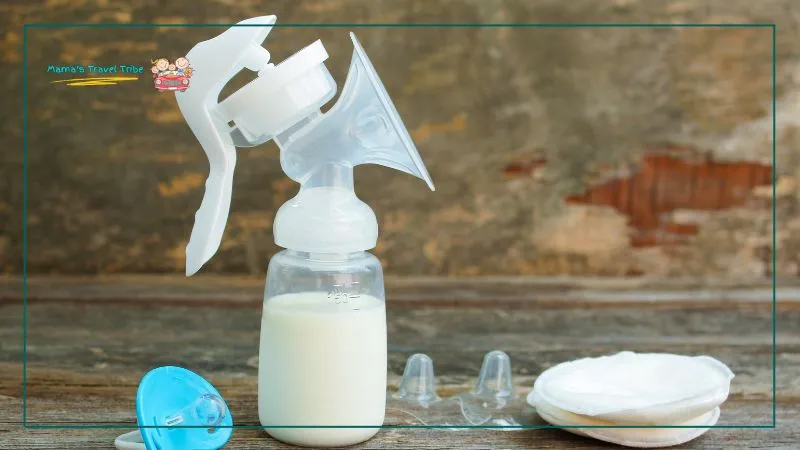“How to keep breast milk frozen while traveling?” is an important question and the answer is simple. By using a high-quality cooler and pre-freezing ice packs, you can ensure your baby’s milk stays safe and fresh. Let’s explore these practical tips to make your travels stress-free and enjoyable.
How To Keep Breast Milk Frozen While Traveling? 10 Tips
To keep breast milk frozen while traveling, use a high-quality, hard-sided cooler with pre-frozen ice packs or dry ice. Pack the milk tightly, minimize opening the cooler, and monitor the temperature with a thermometer. For longer trips, consider a portable freezer or verify hotel and airline policies for additional support.
1. Use a High-Quality Cooler and Label it

Investing in a high-quality, hard-sided cooler is crucial when you want to keep your breast milk frozen while traveling. Hard-sided coolers maintain a stable temperature better than soft-sided ones. I recommend purchasing a cooler with thick insulation. There should also be a tight seal to keep the cold air inside.
When I travel, I always make sure my cooler is labeled clearly. This way, I know exactly what’s inside without having to open it frequently, which helps maintain the cold temperature. You can even use a label maker or simply write on a piece of tape to stick on the cooler.
The best cooler to keep breast milk frozen while traveling is the Yeti Tundra series. These coolers are known for their durability and excellent insulation. They’re a bit pricey, but they’re worth every penny for the peace of mind they offer.
Another good option is the Coleman Steel-Belted cooler, which is more affordable and still does a great job of keeping things cold.
2. Pre-Freeze Your Ice Packs

When you’re getting ready to travel, make sure your gel packs or ice packs are completely frozen before you use them. This is super important because if they aren’t fully frozen, they won’t keep your milk cold enough.
I always double-check my ice packs the night before to make sure they’re rock solid. This little step can make a big difference in keeping everything frozen during the trip.
If you’re wondering how to travel with breast milk by plane, preparation is key. Before your flight, make sure your cooler and ice packs meet the airline’s regulations. Most airlines allow you to carry breast milk and ice packs in your carry-on.
So, inform the security officers at the checkpoint that you’re carrying breast milk. They’re usually very understanding and will help you through the process.
For longer trips, consider using dry ice for breast milk. Most airlines allow you to carry a small amount of dry ice (up to 5.5 pounds) in a well-ventilated container, but it’s always best to verify this ahead of time to avoid any issues at the airport.
3. Pack Tightly

Packing your cooler tightly is another important step to keep your breast milk frozen. When I pack my cooler, I make sure there’s no empty space. Empty space can cause the temperature to rise faster.
You can place the ice packs or gel packs around the breast milk containers, filling any gaps with additional ice packs if necessary.
Remember, the goal is to minimize the amount of air in the cooler. The less air there is, the longer everything stays cold.
4. Seal Breast Milk Bags
Properly sealing your breast milk bags is crucial to keep the milk fresh. Press out as much air as possible before sealing. This helps maintain the temperature and ensures no milk spills out.
You can double-bag the milk for extra security. Place the sealed milk bags into another larger zip-lock bag to provide an extra layer of protection. This is especially helpful if you are traveling for a long period or if the cooler might get jostled around a bit.
5. Use Frozen Towels
Another great tip for keeping your breast milk frozen is to use frozen towels. Before you start your journey, wet some towels and freeze them. Once they are frozen, you can use them to line your cooler. This helps to keep everything inside colder for longer.
When packing, place a layer of frozen towels at the bottom of the cooler, then add your breast milk bags, and cover them with another layer of frozen towels. This method not only keeps the milk cold but also prevents the bags from shifting during the trip.
6. Check Airline Policies
If you are flying, it’s essential to check the airline’s policies on traveling with breast milk and ice packs. The TSA (Transportation Security Administration) allows you to take more than 3.4 ounces of breast milk in your carry-on, but you must declare it at the security checkpoint.
Another tip is to clearly label your cooler as containing breast milk. This can be very helpful during airport security checks and in case the cooler needs to be handled by anyone else during your travels.
I usually use a bold, easy-to-read label to make it obvious what’s inside. This can help speed up the process and avoid unnecessary delays.
7. Minimize Opening the Cooler
To keep your breast milk frozen as long as possible, it’s important to minimize opening the cooler. Every time you open it, warm air gets in, and the cold air escapes, which can reduce the effectiveness of your ice packs. So, plan ahead and only open the cooler when absolutely necessary.
You might be wondering, how long will breast milk stay frozen in a cooler? With the right cooler and properly frozen ice packs, breast milk can stay frozen for up to 24 hours, sometimes even longer.
However, this depends on various factors such as the quality of your cooler, the amount of ice packs, and how often the cooler is opened. By keeping the cooler closed as much as possible, you can maximize the time your milk stays frozen.
8. Consider a Portable Freezer
For very long trips, a portable freezer can be a worthwhile investment. These devices can be plugged into a car’s 12-volt outlet or a regular AC outlet in hotels, providing a reliable way to keep your breast milk frozen no matter how long your journey is. I’ve found that having a portable freezer gives me peace of mind, especially on trips that last several days.
If you’re considering shipping frozen breast milk, a portable freezer can also be very helpful. It ensures that the milk remains frozen during transit, which is critical if you’re sending it over long distances. Always check the specifications of the portable freezer to make sure it meets your needs and is suitable for travel.
9. Use a Thermometer

Keep a thermometer inside the cooler to monitor the internal temperature. This can help you ensure that the milk remains in a safe temperature range.
10. Prepare for the Hotel Stay
If staying at a hotel, contact the hotel in advance to ensure you have access to a freezer. Some hotels may place the milk in their main freezer if the room’s mini-fridge does not have a freezer section.
Now that you know how to keep breast milk frozen on the go, let’s ensure your infant is safe and comfy. For important safety tips when flying with your baby on your lap, check out Safe Skies: 10 Essential Tips for Flying with Your Infant on Your Lap.
Importance of Keeping Breast Milk Frozen
Keeping breast milk frozen is crucial to preserve its nutrients and prevent bacterial growth. Properly frozen milk ensures your baby receives all the benefits of breast milk, even when you’re away from home.
Preserving Nutrients
When breast milk is frozen, it retains all the vital nutrients that your baby needs. If the milk isn’t kept frozen, these nutrients can break down, reducing the milk’s overall quality.
By keeping the milk frozen, you ensure that your baby gets the best nutrition possible. Think of it like keeping fresh fruit in the freezer; it stays fresh and nutritious longer.
Preventing Bacterial Growth
Breast milk that is kept at the correct frozen temperature prevents harmful bacteria from growing. Bacteria can make the milk unsafe for your baby. Keeping breast milk frozen stops these bacteria from developing.
This is similar to why we freeze other foods – it keeps them safe to eat for a longer time. Always make sure your breast milk is stored in a good-quality, tightly-sealed container to keep it safe and clean.
Convenience for Travel
Freezing breast milk makes it much easier to travel. When you have frozen milk, you don’t have to worry about finding a way to keep it fresh on the go. This is particularly important for long trips or when you don’t have access to a refrigerator.
By freezing the milk, you can pack it in a cooler with ice packs, and it will stay safe for your baby until you reach your destination. This makes traveling with your baby much less stressful.
Longer Storage Life
Another important reason to keep breast milk frozen is that it extends the storage life of the milk. Fresh breast milk stays good in the refrigerator for a few days, but when frozen, it can last for several months.
This means you can pump and store milk in advance, ensuring you always have a supply ready when you need it. It’s like having a backup plan, so you’re never caught without milk for your baby.
Mastering the preservation of breast milk is just one part of traveling with a newborn. Ready for more tips? Learn the must-dos for flying with your newborn in Flying with a Newborn: 5 Essential Parenting Tips for a Smooth Flight.
What to Do If Breast Milk Starts to Thaw?
If you notice that your breast milk is starting to thaw, don’t panic. First, if you catch it early and the milk is still mostly frozen, try to refreeze it as soon as possible. Place it back in the cooler with fresh ice packs or in a freezer if one is available.
Refreezing partially thawed milk can still preserve most of its nutrients.
If the milk has completely thawed but is still cold, you should use it within 24 hours. You can keep it in a refrigerator if one is accessible. This is the safest way to ensure your baby gets the benefits of the milk without any risk of spoilage. Just make sure to use it within the day.
In case you’re somewhere without access to a refrigerator or cooler, consider asking for help. For instance, if you’re in a hotel, request them to store the milk in their main freezer. People are usually very understanding and willing to help, especially when it comes to baby care.
Remember, never refreeze milk that has been completely thawed and left out at room temperature. This could cause bacteria to grow, making it unsafe for your baby. Always trust your instincts. If you’re unsure about the safety of the milk, it’s better to be cautious and discard it.
Conclusion
Traveling with breast milk doesn’t have to be stressful. Here’s a quick recap of the key tips to keep your milk frozen and safe:
- Invest in a high-quality, hard-sided cooler.
- Pre-freeze your ice packs and use dry ice for longer trips.
- Clearly label your cooler and keep it tightly packed.
- Minimize opening the cooler to maintain a cold temperature.
- Prepare in advance for hotel stays and airline policies.
By following these tips, you can confidently travel knowing your baby’s milk is safe and ready whenever needed. Safe travels!

